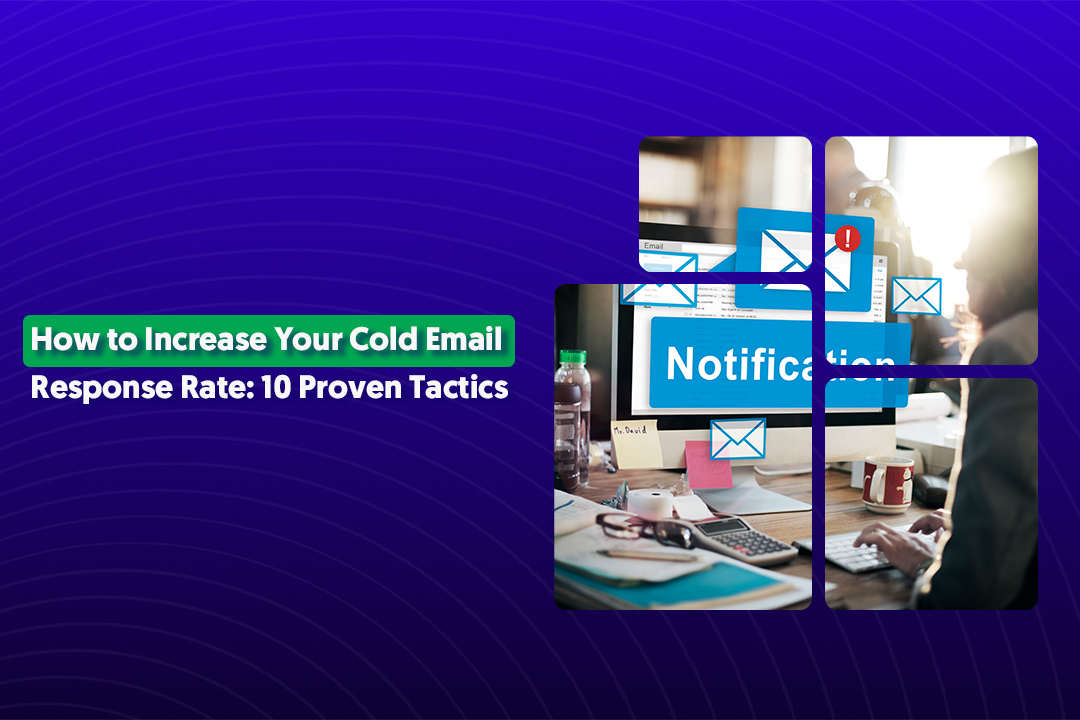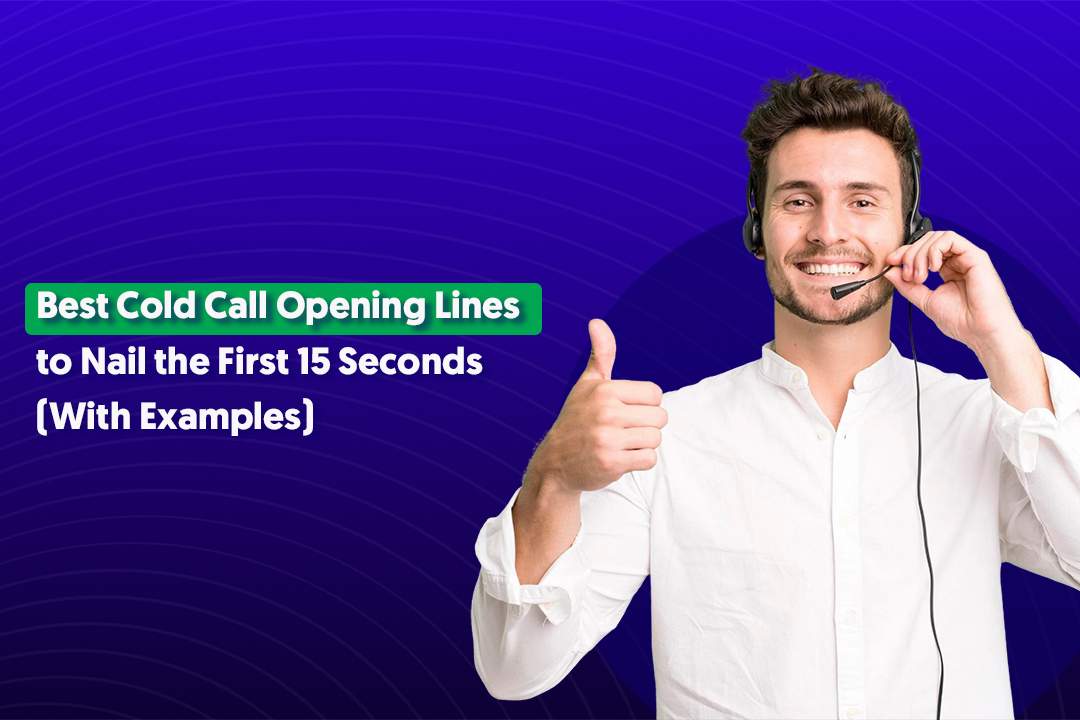Table of Content
Key Takeaways
- Cold email open rates between 30-50% indicate strong deliverability and effective subject lines.
- Deliverability beats clever copy every time—if you're landing in spam, your subject line doesn't matter.
- Clean, verified lead lists are non-negotiable—high bounce rates destroy your domain reputation fast.
- Subject lines should sound like a colleague emailing you, not a marketing campaign.
- Send Tuesday-Thursday, 8-10 AM in the recipient's timezone for maximum opens.
- Domain warming, proper DNS setup, and gradual send volume increases are the foundation of consistent high open rates.
- Monitor weekly metrics: if opens drop 10%+, pause immediately and diagnose the issue before continuing.
Your cold email open rate determines whether your outreach lives or dies.
We've analyzed millions of cold emails across 10,000+ campaigns, and the pattern is clear - if your emails don't get opened, nothing else matters.
Not your pitch, not your offer, not even your closing rate.
Most B2B teams are fighting the same battles: cold email open rates stuck in the single digits, messages landing in spam, subject lines that get ignored, and email lists filled with dead addresses.
You're spending hours crafting the perfect cold email outreach, only to watch it disappear into the void.
The average cold email open rate sits around 20-30%, but we've seen teams consistently hit 50-60% once they nail the fundamentals.
The difference? They treat opens as a science, not a guessing game.
In this guide, we're breaking down the exact tactics that move the needle—backed by real data from campaigns that generated over $312 million in pipeline. No fluff, no theory. Just the specific changes that'll get more eyes on your emails, starting today.
Let's fix your open rates.

What Is a Cold Email Open Rate?
Your cold email open rate is simple math: the percentage of delivered emails that get opened at least once. The formula looks like this: (unique opens ÷ delivered emails) × 100.
So if you send 100 cold emails and 40 people open them, you're sitting at a 40% open rate. Straightforward enough.
But here's where it gets interesting—cold email open rates tell you if people are even giving you a chance, but they don't tell you if your message actually works.
We've seen campaigns with 60% open rates generate zero meetings because the messaging was off. And we've seen 35% open rates convert like crazy because the targeting was surgical.
Open rate matters as your first checkpoint, not your finish line. If nobody opens your emails, you've got a deliverability problem, a subject line problem, or a list quality problem. But if everyone opens and nobody responds?
That's a different issue entirely.
Learn More: How to Increase Your Cold Email Response Rate (Proven Tactics)
The Reality: Open Rates Aren't Always Accurate
Here's what most teams don't realize—average open rate for cold emails data can be misleading because of:
- Apple Mail Privacy Protection (MPP): Apple now pre-loads images in emails, which triggers "opens" even if the recipient never saw your message. This artificially inflates your numbers.
- Email scanners and bots: Security tools open emails to check for threats, showing up as opens in your analytics.
- Forwarded emails: Someone forwards your email internally, and suddenly you've got multiple "opens" from one person.
We track open rates across every campaign we run, but we never optimize for opens alone. The real question isn't "what is a good open rate for cold email"—it's whether those opens convert to conversations.
That's why we focus on meeting-ready leads, not vanity metrics. When you're paying per qualified lead instead of per email sent, the math changes completely.
What Is the Average Cold Email Open Rate? (Updated Benchmarks)
Most B2B cold email campaigns land between 25-45% open rates. That's the realistic range we see across thousands of campaigns. Anything in that zone means your emails are getting delivered and your subject lines aren't terrible.
But here's the thing: average cold email open rate benchmarks are just that—average. They don't account for whether you're emailing CTOs at Series B startups or small business owners running solo operations. Context matters.
Why Your Open Rates Might Look Different
B2B vs B2C is night and day. B2B emails typically hit 30-40% because you're reaching people at work emails who check inbox regularly.
B2C cold emails? You're looking at 15-25% because personal inboxes are flooded, people are less engaged, and your competition includes everything from shopping deals to social notifications.
The average open rate for cold emails also shifts based on:
- Target title: C-suite executives get 200+ emails daily, so their open rates run lower (20-35%). Mid-level managers and individual contributors? Often 35-50% because their inboxes are less slammed.
- Industry: Tech and SaaS see higher engagement (35-45%) compared to traditional industries like manufacturing or retail (25-35%).
- Send volume: Blast 10,000 emails from a new domain and watch your opens crater. Gradual ramp-ups from warmed domains perform better.
- Domain age and reputation: Fresh domains struggle. Aged domains with clean sending history see 10-15% higher opens.
- Personalization level: Generic templates get generic results. We've tested this extensively—even basic personalization (company name, relevant pain point) can push opens from 30% to 45%.

When You're Crushing It: The 70%+ Zone
If you're consistently hitting 70%+ open rates, you're doing two things right: your email deliverability is dialed in, and your subject lines are magnetic.
We've hit these numbers on tightly targeted campaigns with fresh domains, perfect sender reputation, and subject lines that speak directly to specific pain points.
But (and this matters) sky-high opens don't always mean better results. A good open rate for cold emails paired with strong reply rates beats inflated open numbers with zero engagement every time.
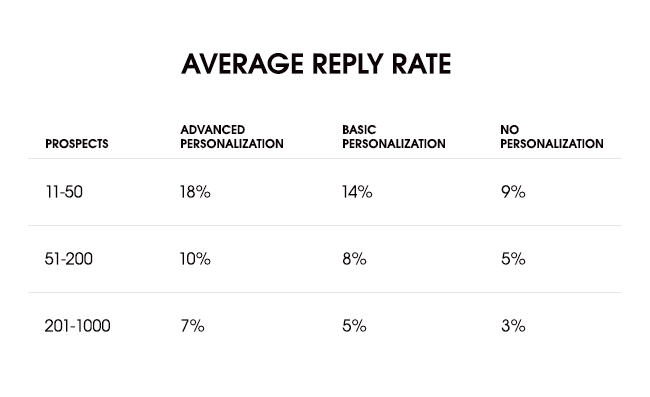
What Is Considered a "Good" Cold Email Open Rate?
Let's cut through the noise: a good open rate for cold emails falls between 50-70%.
If you're consistently in that range, your emails are landing in the primary inbox and your subject lines are doing their job.
Hit 70-90% and you're in excellent territory—the kind of performance that comes from nailed targeting, bulletproof deliverability, and subject lines that feel personal, not spammy.
What Top Performers Actually Do Differently
We've run campaigns across every industry imaginable, and the ones crushing open rates share these traits:
- Clean, warmed domains with proper DNS setup (SPF, DKIM, DMARC all configured).
- Hyper-targeted lists where every contact fits a specific ICP, not scraped databases.
- Subject lines that sound human, not like marketing copy (more on this later).
- Low daily send volumes that mimic natural sending patterns (30-50 emails per inbox).
- High email quality scores because they're landing in primary inbox, not promotions or spam.
Here's what most people miss: a good open rate for cold emails is primarily a deliverability signal, not a copywriting one.
Sure, your subject line matters—but if Gmail or Outlook dumps your email in spam, the best subject line in the world won't save you.
Also Check: Cold Email Outreach Best Practices: The Ultimate Guide
The Reality Check Nobody Talks About
High opens don't pay the bills. Meetings do.
We've seen campaigns with 75% open rates generate two meetings. And we've seen 45% open rates book 30+ meetings in the same timeframe.
The difference? Everything that happens after the open—your messaging, your offer, your targeting accuracy.
This is exactly why our model focuses on meeting-ready leads instead of email metrics. When we're sending outreach for clients, we're not celebrating opens—we're celebrating qualified conversations.
Because at the end of the month, what is a good open rate for cold email matters way less than how many decision-makers showed up on your calendar.
Track your opens. Fix them if they're low. But obsess over what converts.
How We Achieved an 88% Cold Email Open Rate (Real Breakdown)
We hit an 88% cold email open rate on a recent campaign targeting SaaS founders. Not once—consistently, across 2,000+ emails over three weeks.
Here's exactly how we did it, step by step. No secrets, no shortcuts.
Step 1: Domain Setup & Warming (The Foundation)
Your cold email open rate lives or dies on deliverability, and deliverability starts with your domain.
We never send cold emails from a primary business domain. Instead, we set up secondary domains (think: trycleverly.com instead of cleverly.com) and configure them properly:
- SPF, DKIM, and DMARC records all authenticated.
- Custom tracking domain so links don't scream "mass email".
- 30-day warm-up period where we gradually increase send volume (start with 10 emails/day, scale to 50).
Skip the warm-up and Gmail will flag you immediately. We've tested this dozens of times—cold domains crater your opens by 30-40% minimum.

Step 2: Verified Lead List (Zero Tolerance for Bad Data)
Bounces kill sender reputation faster than anything else. Before we send a single email, every address runs through:
- Email verification tools to catch invalid addresses, role accounts, and spam traps.
- Manual LinkedIn cross-checks for high-value targets to confirm they're still at the company.
- Suppression list cleanup removing anyone who previously unsubscribed or marked as spam.
We've seen teams with 60% open rates jump to 75% just by cleaning their lists. Bad data isn't just wasted sends—it actively tanks your deliverability.
Step 3: Hyper-Personalized Subject Lines + Preview Text
Generic subject lines = generic opens. For the 88% campaign, every subject line referenced something specific:
- Company name + relevant trigger event: "Saw [Company] just raised Series A"
- Mutual connection or shared experience: "Quick question about your Gartner listing"
- Direct value prop tied to their role: "Helping SaaS founders fill pipeline without adding headcount"
Preview text matters just as much. It's the second thing people see, so we use it to add context, not repeat the subject line.
Example: Subject: "Pipeline idea for Q1" / Preview: "Most B2B teams are overpaying for underqualified leads—here's a different approach"
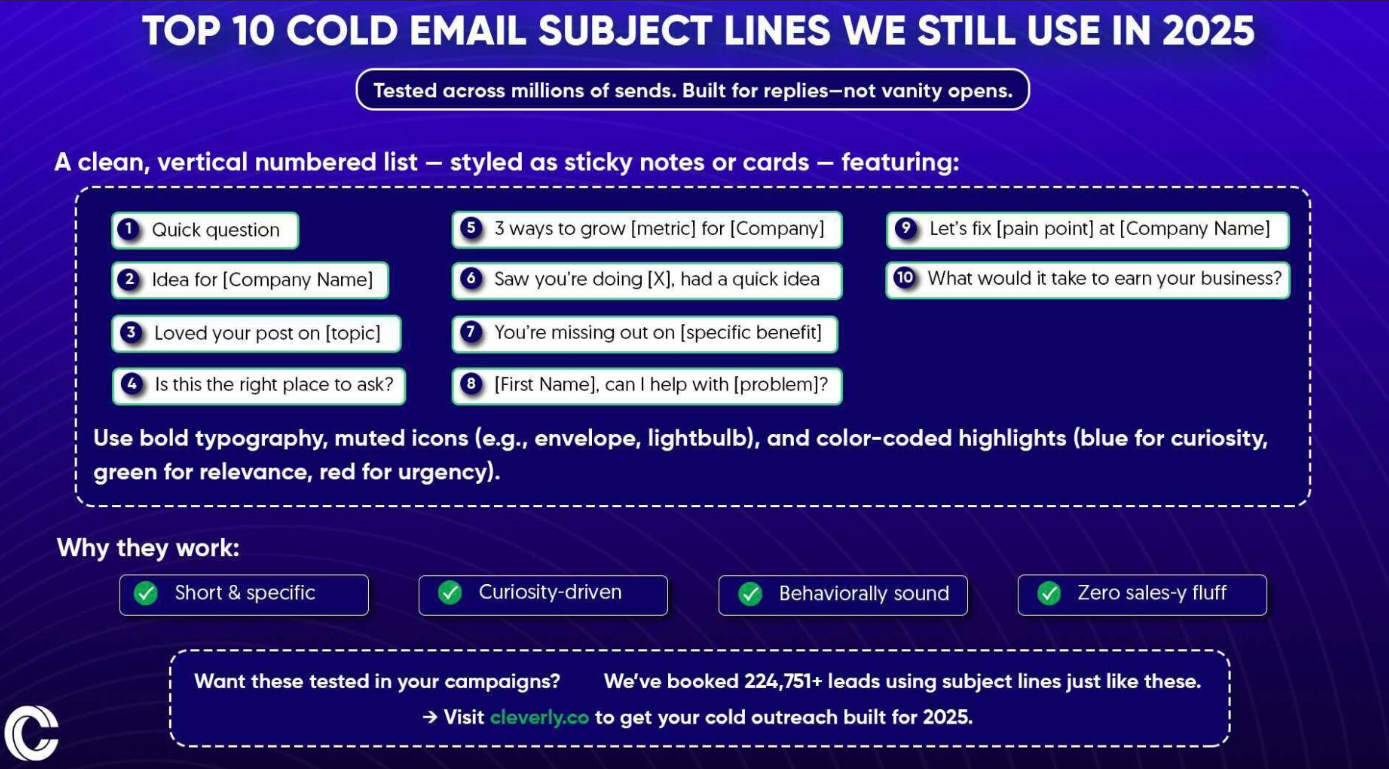
Step 4: Sender Reputation Optimization
Your sending reputation is a score inbox providers assign based on engagement. To keep it high:
- We limit sends to 40-50 emails per domain per day (aggressive sending flags you as a spammer).
- We track engagement rates religiously—if opens drop below 40%, we pause and diagnose.
- We remove non-openers after 2-3 attempts so we're not repeatedly emailing disengaged contacts,
Think of it like a credit score for your email—once it drops, it's hard to rebuild.

Step 5: Time-of-Day & Day-of-Week Testing
We tested send times across 50,000+ emails and found the best time to send cold email were:
- Tuesday-Thursday, 8-10 AM local time consistently outperforms other windows.
- Avoid Mondays (inbox overload) and Fridays (people check out early).
- Timezone targeting matters—sending at 9 AM recipient's time beats sending at 9 AM your time.
For the 88% campaign, we sent Tuesday and Wednesday mornings in the prospect's timezone. Simple change, 12% lift in opens.
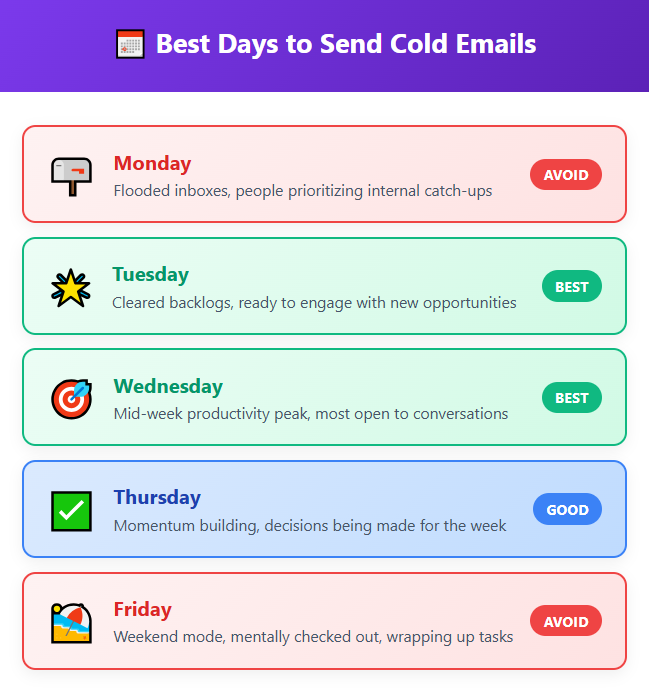
Step 6: Multi-Domain Rotation & Sending Limits
We rotate between 3-5 domains per campaign to distribute send volume and protect each domain's reputation. If one domain gets flagged, the others keep running.
Each domain sends 40-50 emails max per day, mimicking human behavior. Inbox providers track sending patterns—blast 500 emails in an hour and you'll land in spam, even with perfect copy.
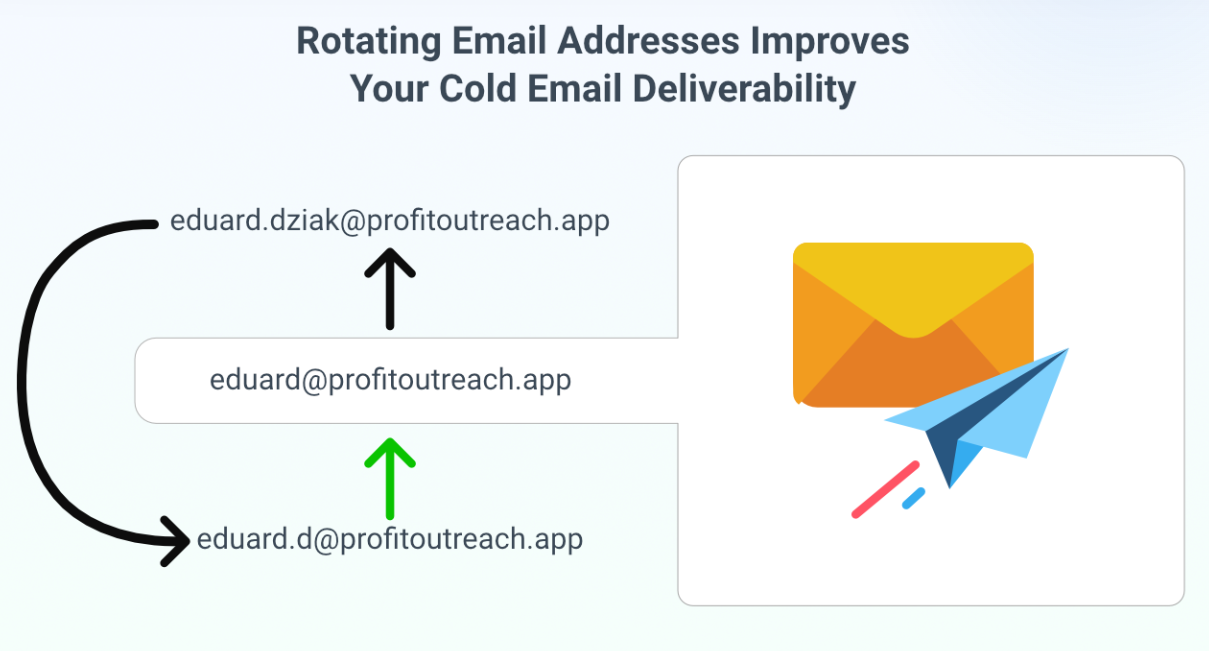
Step 7: Maintaining Deliverability Week Over Week
Cold email open rates don't stay high by accident. We monitor:
- Spam complaint rates (anything above 0.1% is a red flag)
- Bounce rates (keep below 2%)
- Reply rates (healthy engagement signals you're a legitimate sender)
- Domain blacklist checks (weekly scans to catch issues early)
When a domain's performance dips, we reduce volume immediately and investigate. Most teams wait until they're in spam before acting—by then, it's too late.

This is the exact process we run for every client campaign. It's not magic, but it is meticulous. And when you're focused on delivering meeting-ready leads instead of just hitting send, every step matters.
Key Factors That Influence Cold Email Open Rates
Your cold email open rates aren't random. They're the result of dozens of technical and tactical decisions that either help you land in the primary inbox or send you straight to spam.
Here's what actually moves the needle, based on what we've tested across millions of emails.
Domain Reputation Score
Every domain has a hidden reputation score that inbox providers use to decide where your email goes. High reputation = primary inbox. Low reputation = spam folder.
What affects your score:
- Bounce rates (keep below 2%)
- Spam complaints (anything above 0.1% is damaging)
- Engagement rates (opens, replies, forwards all help)
- Sending consistency (erratic volume spikes hurt you)
We've seen cold email open rates drop from 55% to 18% on a single domain after one week of aggressive sending. Your domain reputation is fragile—treat it that way.
More to Explore: Cold Email Blueprint to Generate Leads (100% Tested)

Inbox Placement (The Make-or-Break Factor)
Landing in Primary inbox vs Promotions vs Spam completely changes your outcome:
- Primary inbox: 50-70% open rates are achievable
- Promotions tab (Gmail): Opens drop to 15-25%
- Spam folder: You're done. 0-2% opens if you're lucky.
Most cold email software can't tell you where you landed, which is why we manually test inbox placement using seed accounts across Gmail, Outlook, and Yahoo before scaling any campaign.

Personalization Depth
Generic emails get generic results. But personalization isn't just dropping a first name in the subject line.
Levels of personalization we test:
- Basic: First name, company name (lifts opens by 10-15%)
- Contextual: Recent company news, hiring trends, tech stack mentions (lifts opens by 25-35%)
- Deep research: Specific pain points based on LinkedIn activity, job posts, or podcast interviews (lifts opens by 40%+)
The 88% open rate campaign we mentioned earlier? Every single email had contextual personalization. It takes more time, but the cold email open rates speak for themselves.
Dive Deeper Into: How to Write Cold Emails That Get Replies (Complete Guide)
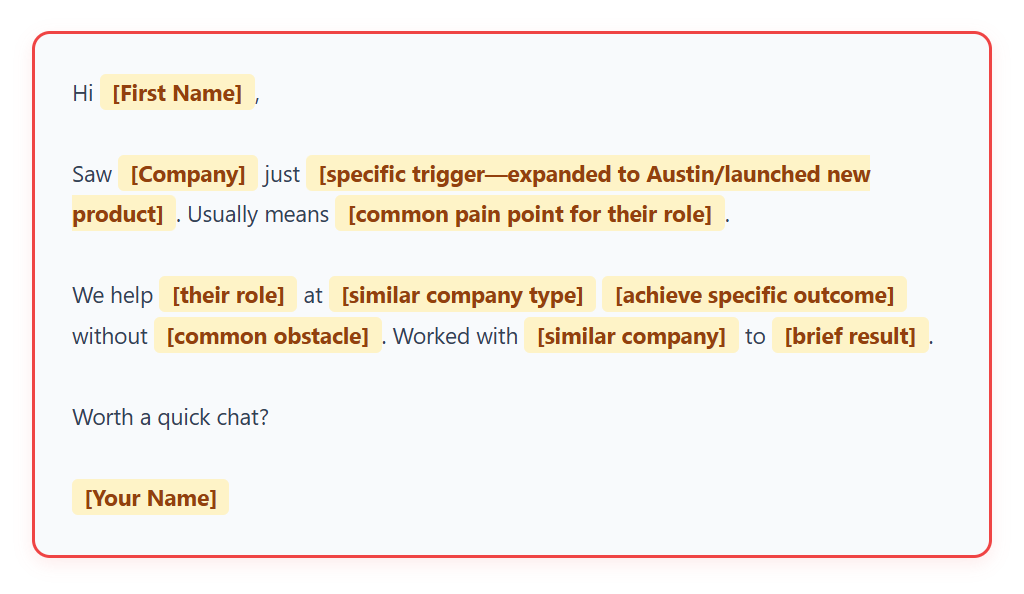
Sending Window
When you send matters almost as much as what you send.
Best-performing windows based on our data:
- Tuesday-Thursday, 8-10 AM recipient's local time
- Secondary window: 1-3 PM for afternoon inbox checkers
- Worst times: Monday mornings (inbox overload), Friday afternoons (people are checked out), weekends (professional emails get ignored)
We've tested the same email sent Tuesday at 9 AM vs Friday at 4 PM—the Tuesday send got 42% higher opens.
Sender Name Conventions
"sales@company.com" screams automation. "John from Cleverly" feels human.
What works:
- First name only: "Michael"
- First name + company: "Sarah at Cleverly"
- Personal domain: "john@johndoe.com" (great for consultants)
What tanks opens:
- "noreply@" anything
- Role-based emails: "sales@", "info@", "team@"
- Overly corporate: "Marketing Department - Company Name"
Your sender name shows up before the subject line on mobile. Make it sound like a real person, not a marketing blast.
Lead Source Quality
Where your leads come from directly impacts cold email open rates:
- Scraped databases: 20-30% open rates (lots of bad data, outdated emails).
- LinkedIn Sales Navigator + verified: 40-55% open rates.
- Hand-researched with trigger events: 60-75% open rates.
- Warm referrals or signal-based: 70-85% open rates.
We built our entire lead generation model around quality over quantity. A verified list of 200 decision-makers beats a scraped list of 5,000 every time—both in opens and in actual meetings booked.
Also Check: What Is Lead Qualification? A Step-by-Step Guide to Qualify Leads

Spam Triggers (The Silent Killers)
Certain words, phrases, and formatting choices tell spam filters to block you:
Common spam triggers:
- Too many links (keep it to 1-2 max)
- All caps in subject lines: "FREE DEMO" or "URGENT"
- Heavy HTML formatting, colored text, or large images
- Spammy phrases: "click here," "limited time," "act now," "buy now," "guarantee"
- Excessive exclamation marks or emojis
Even one trigger word can tank your deliverability. We've A/B tested emails with identical content—one with "free trial" and one with "test it out"—and seen a 22% difference in cold email open rates.
The key? Write like you're emailing a colleague, not running a promo campaign. Simple text, conversational tone, minimal links. If it feels like marketing, it'll get filtered like marketing.
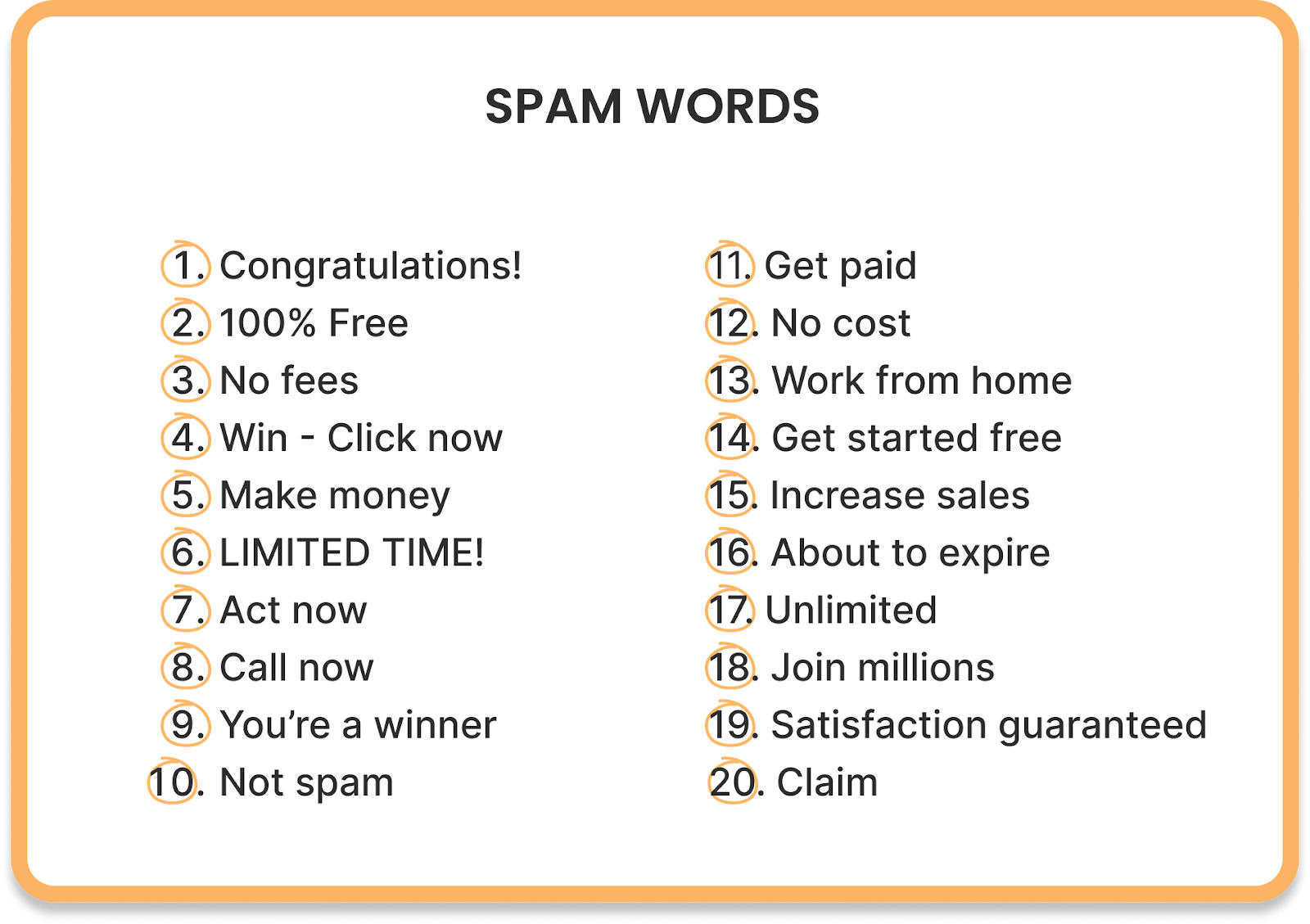
How to Increase Your Cold Email Open Rate (Step-by-Step Framework)
You don't need a complete overhaul to fix your cold email open rate. You need a systematic approach that addresses the right problems in the right order.
Here's the exact framework we use when a client comes to us with struggling open rates. Follow these steps sequentially—each one builds on the last.
Step 1: Audit Your Current Deliverability
Before you touch anything else, figure out where you actually stand.
Run these checks:
- Test your emails across Gmail, Outlook, and Yahoo using seed accounts
- Check your domain against blacklist databases (MXToolbox, Spamhaus)
- Review your bounce rate (should be under 2%)
- Verify SPF, DKIM, and DMARC are properly configured
- Check your spam complaint rate (should be under 0.1%)
If your emails are landing in spam, nothing else matters. Fix deliverability first, optimize copy second.

Step 2: Clean Your Lead List Ruthlessly
Bad data destroys cold email open rates faster than bad copy.
What to remove immediately:
- Invalid email addresses (run through ZeroBounce, NeverBounce, or similar)
- Role-based emails (info@, sales@, contact@)
- Free email domains for B2B outreach (Gmail, Yahoo, Hotmail)
- Contacts who haven't been at the company in 6+ months
- Anyone on suppression lists or who previously marked you as spam.\
We've seen open rates jump from 28% to 49% just by cleaning out 30% of a contact list. Quality always beats quantity.

Step 3: Rewrite Your Subject Lines
Your subject line has one job: get the email opened without triggering spam filters.
Follow these B2B cold email best practices:
- Keep it under 50 characters (mobile screens cut off longer lines)
- Include the company name or specific personalization
- Ask a question or reference a relevant pain point
- Avoid all caps, excessive punctuation, and spam trigger words
- Make it sound like something a colleague would send
Templates that consistently work:
Contextual personalization:
- "Quick question about [Company]'s Q1 outbound"
- "Noticed [Company] is hiring SDRs"
- "Pipeline idea for [Industry] companies"
Mutual connection:
- "[Name] suggested we connect"
- "Following up on [Event/Post]"
Direct value proposition:
- "Different approach to lead gen"
- "Helping [Role] fill pipeline without adding headcount"
Step 4: Optimize Sender Name and Email Address
Your sender name shows up before your subject line on mobile. Make it human.
What works:
- "Sarah" or "Sarah Chen"
- "Michael at Cleverly"
- Personal domain: "john@johnsmith.com"
Use a real person's name from a real email address. It's that simple.
Step 5: Perfect Your Email Body (Opening Lines Matter Most)
If someone opens your email, the first two sentences determine if they keep reading.
B2B cold email best practices for opening lines:
- Reference something specific about their company (recent funding, hiring, product launch).
- Acknowledge a shared pain point in their industry.
- Lead with value, not your credentials.
- Keep the first paragraph to 2-3 sentences max
Template that works:
Subject: Pipeline idea for [Company]
"Hey [First Name],
Noticed [Company] just raised Series B—congrats. Most B2B teams scaling this fast hit the same wall: outbound struggles to keep up without ballooning headcount.
We help companies like [similar client] fill their pipeline without hiring more SDRs. Instead of paying per seat or per email sent, you only pay for qualified meetings we book.
Worth a quick 15-minute call to see if it makes sense for [Company]?"
Step 6: Time Your Sends Strategically
Same email, different send time = 30-40% difference in opens.
Best windows based on our testing:
- Tuesday-Thursday, 8-10 AM in recipient's timezone (primary window)
- Tuesday-Thursday, 1-3 PM in recipient's timezone (secondary window)
- Avoid Mondays (inbox overload), Fridays (checked out), and weekends.
We built timezone detection into every campaign we run. It's a small detail that makes a massive difference in cold email open rates.
Step 7: Set Up Proper Follow-Up Sequences
Most meetings don't come from the first email. They come from follow-ups.
Follow-up framework that works:
- Email 1: Value-focused introduction (Day 1)
- Email 2: "Bumping this up" + add one more insight (Day 4)
- Email 3: "Last note" + different angle or case study (Day 7)
- Email 4: Breakup email—"Should I close your file?" (Day 12)
Keep follow-ups short (2-3 sentences), reference the original email, and add new value each time. Don't just say "following up"—nobody cares.
Step 8: Monitor and Adjust Weekly
Cold email open rates aren't set-it-and-forget-it. Track these metrics weekly:
- Open rate by send day and time
- Spam placement (use seed testing)
- Bounce rate and spam complaints
- Reply rate (opens without replies = deliverability issue brewing)
If opens drop more than 10% week-over-week, pause and diagnose immediately. Usually it's one of three things: deliverability degrading, list quality dropping, or subject line fatigue.
B2B Cold Email Examples That Generated 50%+ Opens
Example 1 - SaaS Founder Outreach:

Why it crushed:
- Opens with a familiar pain point
- Introduces a differentiated model
- Includes social proof from similar company
- Clear, low-friction CTA
Example 2 - Agency Outreach:
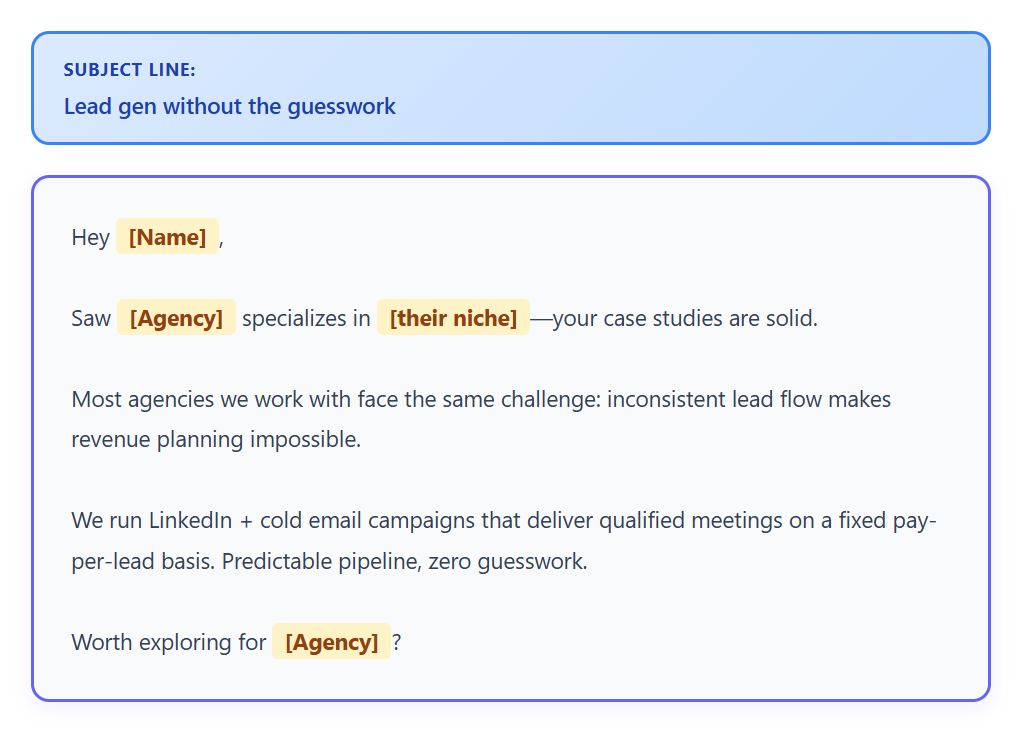
Why it worked:
- Personalized opening (referenced their niche)
- Named their exact pain point (inconsistent leads)
- Positioned the offer as solving that specific problem
- Short, scannable, conversational
These aren't theoretical B2B cold email examples—these are word-for-word templates from campaigns that generated $2M+ in the pipeline.
The framework works. The templates work. Now it's about consistent execution—which is exactly what we handle for clients who'd rather focus on closing deals than managing email infrastructure.
Check More Here: 13+ Sample Emails to Approach New Clients (Proven Templates + Tips)
How Cleverly Helps Companies Achieve High Cold Email Open Rates
We know most teams don't have time to manage domain warm-ups, A/B test subject lines, monitor deliverability scores, and still actually close deals.
That's exactly why we built Cleverly.
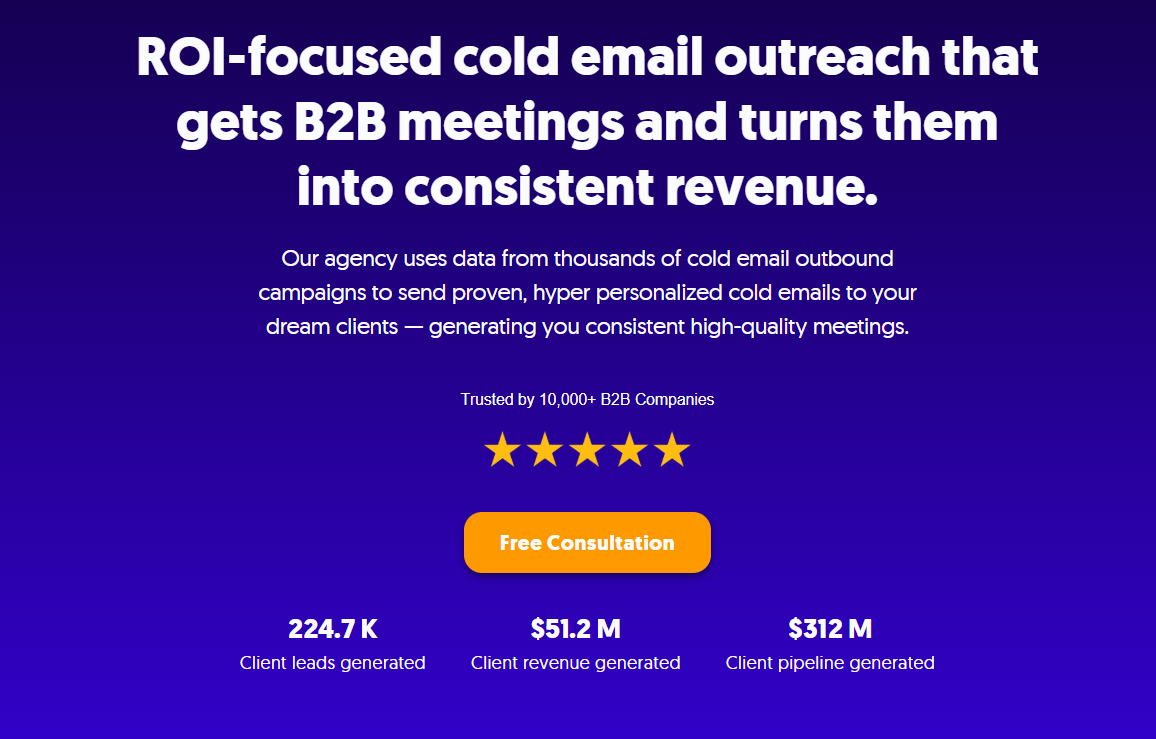
We're a cold email outreach agency that handles the entire process—from infrastructure setup to inbox placement optimization to delivering qualified meetings on your calendar.
You don't pay for emails sent or campaign management hours. You only pay for meeting-ready leads.
What Makes Us Different
We've run over 10,000+ campaigns for companies like Amazon, Google, Uber, PayPal, Slack, and Spotify.
The result? $312 million in pipeline revenue and $51.2 million in closed revenue.
Our average client campaigns consistently hit 50-70% open rates because we treat deliverability as a science:
- Done-for-you domain setup and warming (no technical work on your end).
- Verified, hand-researched lead lists (zero spam traps or bad data).
- Daily deliverability monitoring across Gmail, Outlook, and other providers.
- Subject line and messaging testing based on what converts in your industry.
- Multi-domain rotation to protect sender reputation.
- Real-time optimization when performance dips.
But here's what matters most: we don't stop at opens. We optimize for qualified meetings. If an email gets opened but doesn't book a conversation with a decision-maker, it doesn't count.
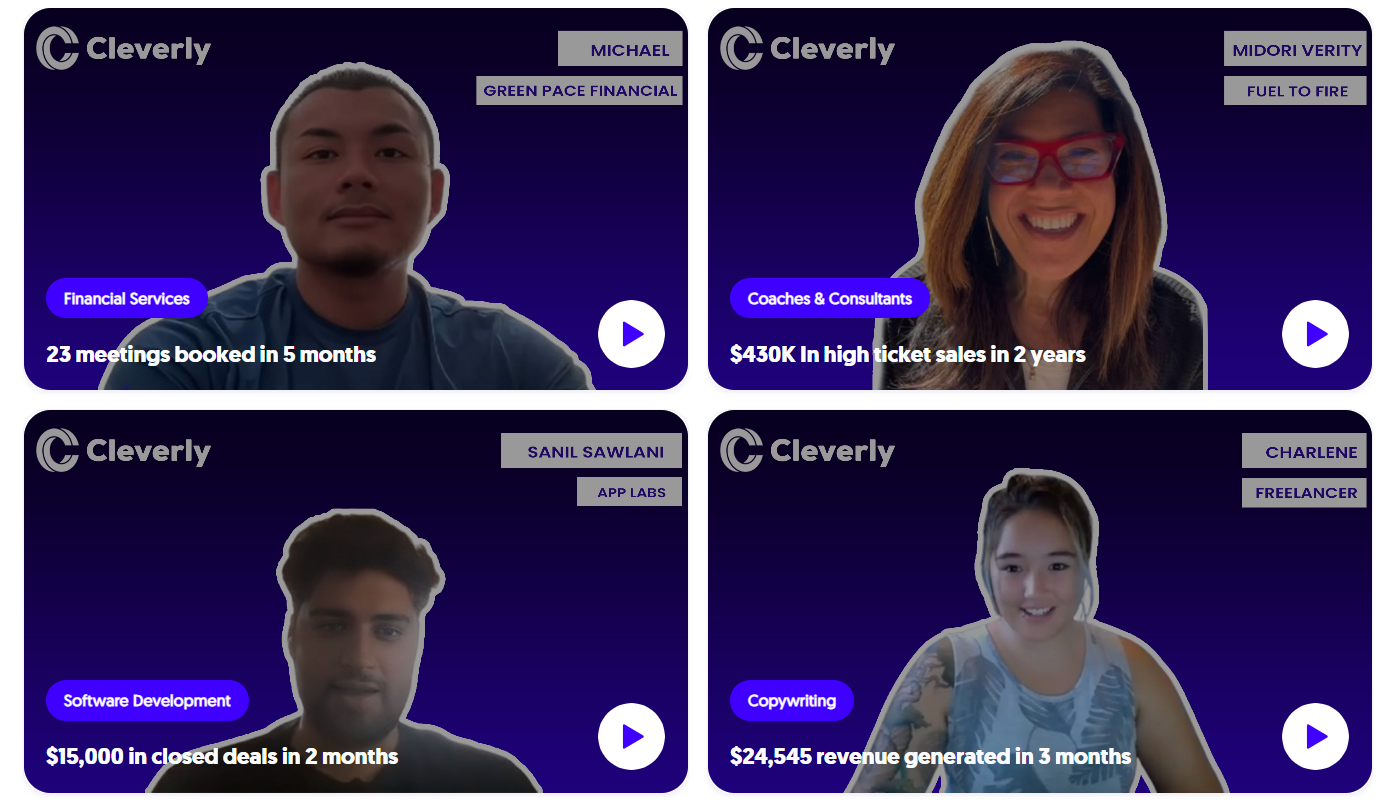
The Model That Changes Everything
Most agencies charge retainers whether they deliver or not. We flip that completely.
You only pay when we send over a qualified lead who's ready to meet. No wasted budget on unqualified clicks. No paying for "efforts." Just results.
Ready to see what 50-70% open rates can do for your pipeline? Book a call with Cleverly and let's build a campaign that actually converts.

Conclusion
Your cold email open rate isn't just a vanity metric—it's the first domino in your entire sales process. If your emails don't get opened, nothing else matters.
The difference between 25% and 70% opens? It's not luck. It's deliverability infrastructure, verified lead data, human-sounding subject lines, and relentless optimization.
Most teams know what needs to be done. They just don't have the bandwidth to do it consistently while also running their business.
Fix your cold email open rates using the framework in this guide, or let us handle it for you. Either way, stop leaving pipeline on the table because your emails are sitting in spam folders.

Frequently Asked Questions



